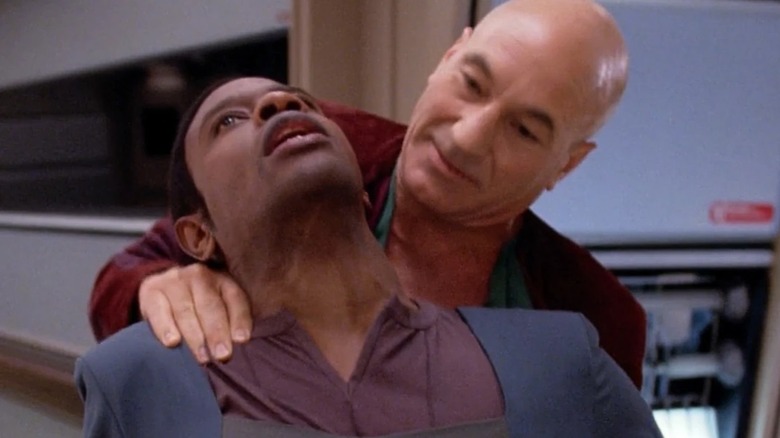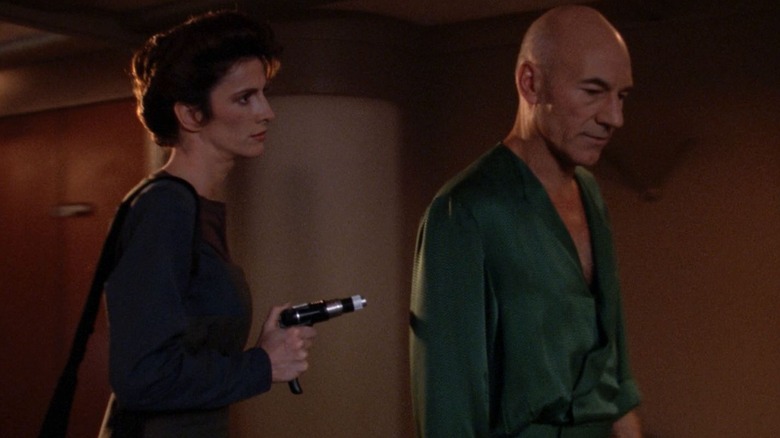One Of The Best Die Hard Rip-Offs Ever Was An Episode Of Star Trek: The Next Generation
In the "Star Trek: The Next Generation" episode "Starship Mine" (March 29, 1993), the U.S.S. Enterprise has to undergo a massive, shipwide maintenance routine that requires every single living being — including the plants — to be cleared off the ship. It seems that, in its many merry adventures, the Enterprise has taken on a great deal of toxic particles that need to be cleared from the ship's systems. The best way to do this is to run a slow-moving wall of concentrated baryon particles through the entire starship. The field is lethal to organic materials, so everyone has to get off the Enterprise immediately. It's the sci-fi equivalent of getting one's house tented for termites.
This leaves the Enterprise's senior staff in the care of one Commander Calvin Hutchinson (David Spielberg), who aims to pass the time with an extended reception on the planet below. A chatterbox of the highest order, no one wants to spend time with Hutchinson. Only Data (Brent Spiner), who has recently downloaded a specialized "small talk" program into his android brain, is able to match Hutchinson's volume of meaningless anecdotes.
During the reception, a bored Captain Picard (Patrick Stewart) learns that the planet he's on features an extensive network of horse riding trails. Although the weather will be extremely inclement, Picard insists on leaving the reception to go riding. The conditions are perfect for him. Picard checks the time and finds that he has just enough time to return to the Enterprise to get his personal saddle. Yes, he carries one on board.
While retrieving his saddle from the empty Enterprise, Picard finds that, well, it's not entirely empty. A strange cadre of suspicious figures, he finds, are lurking around the corridors, doing suspicious things. No points for guessing that these people are secret terrorists, on the Enterprise for dastardly reasons. The episode that follows is perhaps the best homage to "Die Hard" made up to that point. It's Picard vs. terrorists in an empty Enterprise, and it's one of the better episodes of the season.
Starship Mine is Die Hard: Star Trek Edition
Picard will eventually learn that the terrorists are scouring the Enterprise's engines for trilithium resin, a dangerous byproduct that can be converted into a powerful explosive. The leader of the terrorists, Kelsey (Marie Marshall), intends to steal it and sell it to an as-yet-undetermined military power. When the terrorists discover Picard on board, he plays dumb, claiming to be the ship's barber, Mot. This works because Picard is out of uniform. The effects of the baryon field ensure that no phasers, transporters, or any of the usual tech available on the Enterprise will work, so Picard has to find clever, non-high-tech ways to evade capture and stop the terrorists.
Oh yes. Tim Russ plays one of the terrorists.
Meanwhile, on the planet below, some of Kelsey's men have been installed to make sure the Enterprise's senior staff doesn't go anywhere. Unfortunately for them, Geordi (LeVar Burton) discovers their weapons locker before they execute their plan to take hostages, forcing their hand. They shoot Geordi, knocking him unconscious. Riker (Jonathan Frakes), Troi (Marina Sirtis), Dr. Crusher (Gates McFadden), and Data have to find a way to incapacitate their captors without them getting suspicious. Poor Hutchinson will not survive the day.
"Starship Mine" is as tense an action story as "Star Trek" has ever done, and its premise would have made for a decent feature film. Patrick Stewart, who is ordinarily asked to play Picard with a staid sense of taciturn professionalism, was given a great gift with "Starship Mine," as it allowed him to be an action hero. Picard is seen constructing flash bombs, and he gets to shoot bad guys with a crossbow. Stewart is clearly relishing in the part.
Starship Mine is also very good
It's worth remembering that throughout the late 1980s and early 1990s, theaters were lousy with "Die Hard" knockoffs. John McTiernan's 1988 actioner was so popular that it became a go-to pitch-session unto itself. Everyone wanted to imitate its one-location setup, its single beleaguered hero, and its distant villain who communicates remotely with the hero. Jan De Bont's 1994 film "Speed," for instance, was often described as "Die Hard on a Bus." The 1992 Wesley Snipes film "Passenger 57" was "Die Hard on a Plane." Andrew Davis' 1992 military thriller "Under Siege" was "Die Hard on a Battleship." More recently, Roland Emmerich resurrected the "Die Hard" knockoff for a new generation in his 2013 film "White House Down." It was, as you might guess, "Die Hard in the White House."
But "Starship Mine," which aired in 1993, did it more cleverly. Perhaps the show's one-hour format forced the writer of "Starship Mine," Morgan Gendel, to keep the story trim. There aren't a lot of subplots, and the action is kept to a minimum. It's also great to see "Next Generation" so effectively create an action story out of existing sets. It's one of the best bottle episodes of the series.
If one might level any complaints at "Starship Mine," it's that it isn't very thematically rich. Picard is out of character as an action star, but he has no moments of self-reflection or philosophies to impart. He simply has to be smart and work on his vigilante skills. It's not until near the end of the episode that Kelsey reveals she's stealing the trilithium resin for profit, and Picard is a little disgusted. Really? Capitalism? Picard is annoyed that he's dealing with such an outmoded system of trade. (Recall that there's no money in Starfleet.)
If anything, "Starship Mine" is about how money, if allowed to drive us, will lead to violence and death. It's not much, theme-wise, but it's in keeping with the spirit of "Star Trek."


